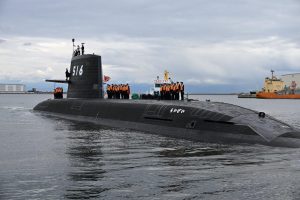A Japanese Defense Ministry panel called for exploring the use of “next-generation propulsion systems” for new submarines equipped with vertical launch systems (VLS) capable of firing long-range missiles.
The blue-ribbon panel, formally named the “Expert Panel on Fundamental Reinforcement of Defense Capabilities,” was established in February 2024 to review the progress of the three new strategic security documents, such as the Defense Buildup Program, formulated by the then-Kishida Fumio administration in December 2022. The panel also aimed to identify and address future challenges.
The final report, submitted to Defense Minister Nakatani Gen on September 19, highlights shortcomings in Japan’s current defense capabilities that should be overcome.
In the report, most notably, the expert panel said VLS-equipped submarines should carry long-range missiles while possessing the capability to remain submerged for long periods of time and over long distances.
To achieve this, the panel emphasized the need to pursue research and technological development that includes “consideration of utilizing next-generation propulsion systems without being bound by conventional precedents.”
The panel did not specify what kind of “next-generation propulsion systems” it envisions. But a defense official who served as the panel’s secretariat said at a press briefing on September 18 that next-generation propulsion systems primarily refer to solid-state batteries and fuel cells.
However, at the briefing, Japanese reporters persistently pressed about the possibility of nuclear propulsion (i.e., the introduction of nuclear-powered submarines). The official responded with answers such as “We’re not ruling out any possibilities,” “No decision has been made by the Ministry of Defense,” and “Nothing has been decided yet.”
As a result, many media outlets mentioned nuclear power as if it were the only possible next-generation propulsion system.
However, nuclear power is by no means a “next-generation” power source. Nuclear energy technology was developed in the mid-20th century and has a history of over 70 years.
If the Ministry of Defense were to try to introduce nuclear submarines in the future based on this report, there would likely be strong backlash from the opposition parties and the public, who would question whether this could be called a “next-generation propulsion system.”
The Japan Maritime Self-Defense Force (JMSDF)’s latest Taigei-class diesel-electric attack submarine (SSK) is equipped with lithium-ion batteries in place of lead-acid ones. Lithium-ion storage batteries have more than twice the energy density of previous lead-acid batteries, improving underwater cruising capabilities and greatly extending underwater time.
But it is still difficult for the Taigei class to carry the VLS because of its relatively small hull size and limited power supply compared to nuclear submarines.
If Japan is to build a new submarine class with a vertical launcher capable of launching long-range missiles from underwater, the new submarine hulls will have to be larger than now and secure additional power supply capacity.
In addition, it is also inevitable that Japan’s new submarine will need to carry next-generation high-powered sonar and various underwater unmanned vehicles (UUVs), all of which will require a larger amount of power than Japan’s existing submarines.
Under the nation’s current Defense Buildup Program (covering fiscal years 2023-2027), the 11th Taigei-class submarine will likely be built as the last of the class during FY2027.
The construction of the next class of submarine will likely start in the following FY2028 budget. That means the Defense Ministry and the JMSDF must begin serious consideration of the next-generation submarine now.
Attention will be focused on the type of propulsion system that will be used for Japan’s new class of submarines. This will clearly indicate how and how far the JMSDF will operate its submarines in the future, with China’s increasing maritime expansion in mind.
Beyond submarines, the blue-ribbon panel also proposed that Tokyo ease its arms export rules to deepen ties with like-minded partners.
Under the current implementation guidelines for the Three Principles on Transfer of Defense Equipment and Technology set out in 2014, weapons exports are limited to five purposes: rescue, transportation, vigilance, surveillance, and minesweeping.
For this reason, Japan cannot send weapons such as guns, missiles, or tanks to Ukraine, and has only provided it with non-lethal defense equipment such as helmets and bulletproof vests.
“Although rules such as the so-called ‘five categories’ have been established, it is necessary to broaden the scope of transfers based on practical realities and with public understanding,” the report stated. “One possible approach is to allow unrestricted transfers to the countries that maintain friendly relationship with Japan, share values such as freedom and democracy, and are under threat from other nations.”
The report also pointed out that advances in cutting-edge technologies such as drones, artificial intelligence (AI), communications, image processing, and robotics are dramatically changing battlefield combat. The expert panel emphasized that Japan must confront the security environment head-on and implement measures to address the changes, which are occurring at a speed beyond previous expectations.
“It must be said that Japan is lagging behind in the introduction of unmanned assets. How to fight using unmanned assets is an issue that requires urgent attention, and we should work to materialize the concept as quickly as possible and accelerate the introduction of unmanned assets, without waiting for the next National Defense Strategy and Defense Buildup Program,” the report pointed out.





























